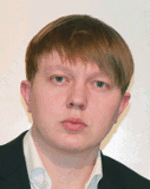 |
|
Biography
Alexander Makarov was born in Volgograd, Russia, in 1985. He studied information technology at the Volgograd State Technical University, where he received the BSc degree in 2006 and MSc degree in 2008. He joined the Institute for Microelectronics in October 2009 and has obtained the doctoral degree in March 2014. He is currently employed as a post-doc researcher. His scientific interests include Monte-Carlo simulations and nonvolatile memory device modeling.
Concept of a Bias-Field-Free Spin-Torque Oscillator Based on Two MgO-MTJs
New types of spintronic devices utilizing all-electrical magnetization manipulation by current, such as spin-torque transfer random access memory and spin-torque oscillators, have been developed based on MgO Magnetic Tunnel Junctions (MTJs) with a large magneto-resistance ratio. Spin-torque oscillators based on a single MTJ with in-plane magnetization show high frequency capabilities, but still need an external biasing magnetic field and are characterized by low output power level. Oscillators on MTJs with perpendicular magnetization and vortex-based oscillators are shown to generate oscillations without external magnetic field, however, their low operating frequencies, usually below 2GHz, limit their functionality and applications as tunable oscillators.
We investigated a penta-layer MTJ structure with only half-elliptic pinned layers. We find that this structure develops stable oscillations with nearly constant amplitude and operates without a biasing field. We note that the frequency of the oscillations only slightly depends on the current value. This is due to the fact that despite the partial coverage of the free layer by the fixed layers, resulting in spin-current injection in only a part of the free layer, free layer magnetization switching still occurs at larger current densities, limiting the range of currents at which oscillations are observed.
In order to prevent the switching of the free layer, thus improving oscillatory behavior control, we have added the second MgO-MTJ to the system (Fig. 1). We find that, in contrast to the previously considered case, the structure with two MgO-MTJs demonstrates stable oscillations with constant amplitude. Next, the influence of the current density ratio ja/jb on the oscillation frequency is studied. The simulation results show that increasing the ratio ja/jb increases the oscillation frequency. We show that such a structure is characterized by a wide variability of high oscillating frequencies from a few GHz to several ten GHz. The dependence of the oscillation frequency on geometry and current density makes these structures attractive for high frequency applications.

Fig. 1: Schematic illustration of a spin-torque oscillator based on two MgO-MTJs. Colored arrows indicate the current direction in each MgO-MTJ.



